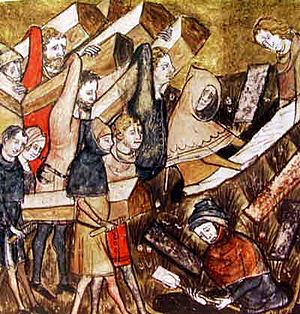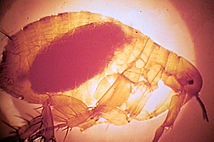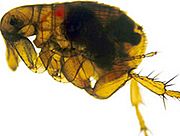Black Death facts for kids

|
|
| Disease | Bubonic plague |
|---|---|
| Location | Eurasia and North Africa |
| Date | 1346–1353 |
|
Deaths
|
25,000,000 - 50,000,000 (estimated) |
The Black Death was a pandemic in Europe and Asia during the 14th century. The outbreak of the disease was at its worst between 1347 and 1351.
Plague was reportedly first introduced to Europe via Genoese traders from their port city of Kaffa in the Crimea in 1347. From Italy, the disease spread northwest across Europe, striking France, Spain, Portugal, and England by June 1348, then spreading east and north through Germany, Scotland and Scandinavia from 1348 to 1350. It was introduced into Norway in 1349 when a ship landed at Askøy, then spread to Bjørgvin (modern Bergen). Finally, it spread to northwestern Russia in 1351. Plague was less common in parts of Europe with less-established trade relations, including the majority of the Basque Country, isolated parts of Belgium and the Netherlands, and isolated Alpine villages throughout the continent.
The disease killed between 50 million and 100 million people across Europe.
Historians cannot be sure which disease caused the Black Death. However, most think that it was the bubonic plague. This disease was carried and spread by fleas living on rats, which traveled on Genoan ships and brought the plague to port cities around the Mediterranean. Another version suggests that traders from the Silk Road may have brought the infected fleas to Europe.
When the fleas bit somebody, they would inject a little bit of the bacteria into the wound. This would cause the person to be infected. In humans, the disease caused swelling in the groin, under the arms and behind the ears. These swellings were a black and purple colour, hence the name 'The Black Death'. The dark swellings were called buboes. People were in pain and victims died a horrible death. The symptoms could be seen 3-7 days after victims were bitten by a flea.
Not everybody agrees that plague caused the Black Death. Some historians have suggested that anthrax or a viral hemorrhagic fever caused the pandemic.
The plague repeatedly returned to haunt Europe and the Mediterranean throughout the 14th to 17th centuries. According to Jean-Noël Biraben, the plague was present somewhere in Europe in every year between 1346 and 1671 (although some researchers have cautions about the uncritical use of Biraben's data). The second pandemic was particularly widespread in the following years: 1360–1363; 1374; 1400; 1438–1439; 1456–1457; 1464–1466; 1481–1485; 1500–1503; 1518–1531; 1544–1548; 1563–1566; 1573–1588; 1596–1599; 1602–1611; 1623–1640; 1644–1654; and 1664–1667. Subsequent outbreaks, though severe, marked the plague's retreat from most of Europe (18th century) and northern Africa (19th century).
Contents
Causes
Due to climate change in Asia, rodents began to flee the dried-out grasslands to more populated areas, spreading the disease. The plague disease, caused by the bacterium Yersinia pestis, is commonly present in populations of fleas carried by ground rodents, including marmots, in various areas, including Central Asia, Kurdistan, Western Asia, North India, Uganda and the western United States.
Y. pestis was discovered by Alexandre Yersin, a pupil of Louis Pasteur, during an epidemic of bubonic plague in Hong Kong in 1894; Yersin also proved this bacillus was present in rodents and suggested the rat was the main vehicle of transmission. The mechanism by which Y. pestis is usually transmitted was established in 1898 by Paul-Louis Simond and was found to involve the bites of fleas whose midguts had become obstructed by replicating Y. pestis several days after feeding on an infected host. This blockage starves the fleas, drives them to aggressive feeding behaviour, and causes them to try and clear the blockage via regurgitation, resulting in thousands of plague bacteria flushing into the feeding site and infecting the host. The bubonic plague mechanism was also dependent on two populations of rodents: one resistant to the disease, which act as hosts, keeping the disease endemic, and a second that lacks resistance. When the second population dies, the fleas move on to other hosts, including people, thus creating a human epidemic.
Medical aspects
The medical knowledge of the time was based on Hippocrates's theory of humorism, which said the body consists of different fluids. If they are in harmony, a person is healthy. If they are not, disease results. Very often, diseases were also seen as a punishment from God.
The theory of humorism did not explain why disease spreads from one person to another. Most people thought that infection was caused by miasma ("bad air"). The bad air could come from within the earth and so cause the disease. Remedies against the disease included opening only north-facing windows, not sleeping during the day, and not working too hard.
In 1348, Philip VI of France asked the Faculty of Medicine of the University of Paris about the cause of the Black Death. It concluded that the pandemic had been caused by a bad conjunction of Jupiter, Saturn and Mars on 20 March 1345. Since that answer was based on astrology, many people believed it, and it was translated into many languages.
Because nobody understood what caused the plague, doctors had no effective treatments. Often, doctors simply told their patients to go to Confession so that their sins would be forgiven if they died. Eventually, the pandemic caused doctors to change their ideas about how the human body worked. Just 200 years later, Girolamo Fracastoro discovered that diseases spread through infection.
Lack of hygiene
The importance of hygiene was not recognized until the 19th century and the germ theory of disease. Until then streets were usually unhygienic, with live animals and human parasites facilitating the spread of transmissible disease.
By the early 14th century, so much filth had collected inside urban Europe that French and Italian cities were naming streets after human waste. Pigs, cattle, chickens, geese, goats and horses roamed the streets of medieval London and Paris.
Medieval homeowners were supposed to police their housefronts, including removing animal dung, but most urbanites were careless.
In much of medieval Europe, sanitation legislation consisted of an ordinance requiring homeowners to shout, "Look out below!" three times before dumping a full chamber pot into the street.
Early Christians considered bathing a temptation. With this danger in mind, St. Benedict declared, "To those who are well, and especially to the young, bathing shall seldom be permitted." St. Agnes took the injunction to heart and died without ever bathing.
Impact
There are no exact figures for the death toll; the rate varied widely by locality. Some estimate that the Black Death may have killed between 75,000,000 and 200,000,000 people in Eurasia.
The Black Death also changed Europe's social structure. It was a serious blow to the Roman Catholic Church and resulted in widespread persecution of minorities such as Jews, Muslims, foreigners, beggars and lepers. The uncertainty of daily survival influenced people to live for the moment, as illustrated by Giovanni Boccaccio in The Decameron (1353).
The initial fourteenth-century European event was called the "Great Mortality" by contemporary writers and, with later outbreaks, became known as the 'Black Death'.
Interesting facts about the Black Death
- "Black death" was not used to describe the plague pandemic in English until the 1750s. The expression had been popularized by Swedish and Danish chroniclers in the 15th and early 16th centuries, and in the 16th and 17th centuries was transferred to other languages as a calque. Previously, most European languages had named the pandemic a variant or calque of the Latin: magna mortalitas, lit. 'Great Death'.
- The Black Death was the second great natural disaster to strike Europe during the Late Middle Ages, the first one being the Great Famine of 1315–1317.
- Research from 2017 suggests plague first infected humans in Europe and Asia in the Late Neolithic-Early Bronze Age.
- It has been suggested that the Black Plague, like other outbreaks through history, disproportionately affected the poorest people and those already in worse physical condition than the wealthier citizens.
- The word "quarantine" has its roots in this period, though the practice of isolating people to prevent the spread of disease is older. In the city-state of Ragusa (modern Dubrovnik, Croatia), a thirty-day isolation period was implemented in 1377 for new arrivals to the city from plague-affected areas. The isolation period was later extended to forty days, and given the name "quarantino" from the Italian word for "forty".
Related pages
Images for kids
-
Yersinia pestis (200 × magnification), the bacterium which causes plague
-
Pieter Bruegel's The Triumph of Death reflects the social upheaval and terror that followed plague, which devastated medieval Europe.
-
A plague doctor and his typical apparel during the 17th Century Outbreak.
-
Contemporaneous painting of Marseille during the Great Plague in 1720
See also
 In Spanish: Peste negra para niños
In Spanish: Peste negra para niños











